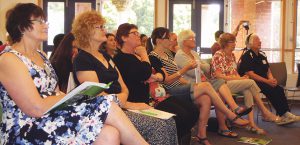WelCom April 2017
Diocesan News
David Loving-Molloy, Catholic Deaf Ministry
The 2017 two-day National Catholic Deaf Conference in February at the Home of Compassion, Island Bay, looked at where Catholic Deaf Ministry has come from in New Zealand and its challenging path ahead in forming supportive relationships and communities.
Historically, the socio-linguistic cultural group identified as the Deaf Community, arose out of social and sporting gatherings of past-pupils of deaf schools. Deaf societies, clubs, and associations were formed. However, recent changes in deaf education and technology have altered their community composition.
Most profoundly deaf children are now mainstreamed rather than attending deaf schools, resulting in the closure of some deaf schools and the downsizing of others. With the ready availability of advanced technologies, the old ‘oral versus manual’ teaching debate has largely become redundant. Though the re-introduction of Sign Language as an ‘education tool’ is still used for students assessed as ‘high needs’.
Technologically, cochlear implant (CI) developments are having a profound effect to enable a deaf person to ‘hear’ more effectively. Mainstreaming and CIs are radically changing the face and culture of deaf communities and of Catholic Deaf Ministries.
Deaf communities and clubs are largely voluntary organisations, which in the past had a direct link to Deaf schools and students. Mainstreaming has severed this link so communities now rely largely on the deaf education system to forge relationships between deaf students (and their parents) and deaf adults.
In Catholic Deaf Ministry, most Catholic Deaf students no longer have access to a Catholic Deaf school. New Zealand’s only Catholic Deaf School, St Dominic’s, was run by Dominican Sisters in Island Bay from 1944 and closed 45 years later in Feilding in 1989.
New Zealand has about 188 Catholic primary schools and 49 Catholic secondary schools. In the Palmerston North and Wellington dioceses, 38 primary-school and 35 secondary-school deaf and hearing-impaired students have been identified over a wide area. These students are the future of Catholic Deaf Ministry for the dioceses. Our challenge nationally is to find out where all the Catholic Deaf children and students are in the other four New Zealand dioceses of Auckland, Hamilton, Christchurch, and Dunedin to form networks.
David Loving Malloy is Chaplain for the Catholic Deaf Centre, at Palmerston North Diocesan Centre.
